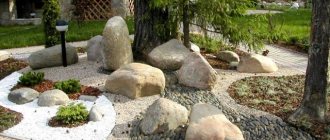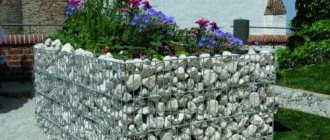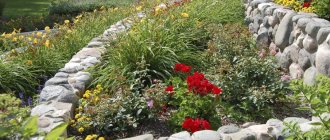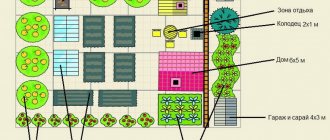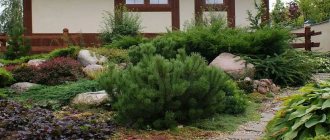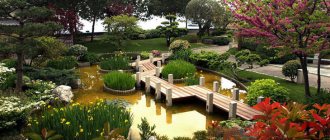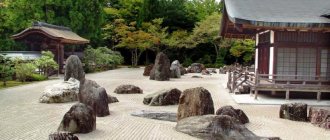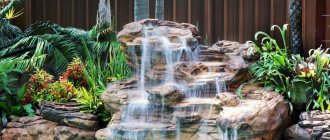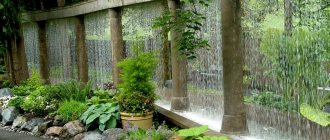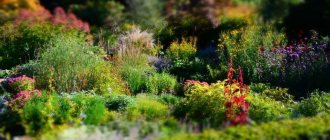What is a rock garden and its purpose?
In the traditional sense, it is a combination of natural materials such as stone. sand and plants, symbolizing their unity in Japanese culture. This area is called a Zen sanctuary and is intended for quiet solitude, such as meditation. Therefore, such a garden in Japan has a slightly philosophical or even religious connotation.
To keep it simple, at its core it is a neat flowerbed decorated with stones and plants.
However, designers are very fond of this composition for decorating suburban areas in our country, using it both as an area for privacy and simply as decoration. Here you can relax, relieve stress, or just relax.
The basic philosophy of such a composition
There are many types of such gardens, but they are all united by one idea, this is the unity of stone and plants and to show that even weak plants can live among stones and sand.
Benefits of using stone
The use of this group of materials has a number of undeniable advantages, let’s consider the most important of them:
| Low cost of project implementation | Of course, you can purchase expensive materials to create this or that composition, but it is much easier to collect natural materials yourself, especially since outside the city there are usually no problems with this, just drive around the nearby fields - as a rule, you can find a lot of material along the edges |
| Ease of operation | Most objects that are made using stone are very easy to implement. You don’t need special tools and equipment; everything can be done on your own using available tools and gardening tools. |
| Variety of options | You can use both natural and artificial stones for your garden. The advantage of the first option is the richness of textures, sizes and shapes. The second option is good because it can be used to imitate any natural structure, and using paints and varnishes, you can give the elements any color |
| Excellent work result | Even such a simple option as finishing a flower bed around the perimeter transforms the area and gives it a new look. And if you create more complex options, you can get unusually attractive compositions that will make your dacha original and unique. |
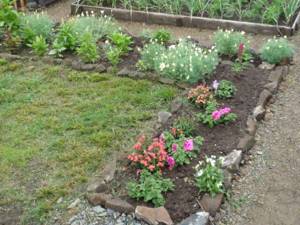
Place stones along the paths, and they will make the area neater, in addition, they will act as limiters, since a curb stone for a summer house is not the best option
How to make a rock garden with your own hands, instructions with photos
The creation of such a zone in Japan is carried out by people who specifically study the philosophy of the rock garden. They take into account everything: the size of the plot, the surrounding landscape, the surrounding flora, etc. Select the size and color of stones and plants. But we don’t have to complicate things like that, since such a composition is purely decorative in nature as a decoration for the site.
Choosing a place
. First we need to decide on the place where you want to place the rockery. If we take into account that the purpose of a rock garden is to create a place where a person can retire, it means that it is better to place it away from view. Choose a place so that it is hidden and not visible from the windows of either your house or your neighbors’ house.
If you have secluded areas or neglected corners in your garden, these would be great for such an area.
If there is an artificial pond on your site, first of all you should look for a place near it. The result will be a very interesting and harmonious zone.
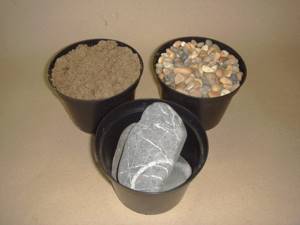
Selecting materials
. To create such a composition you will need large stones and slightly smaller stones (can be of different colors), purified sand and plants. We buy stones in the ratio of 1 large to 3-4 smaller ones. You can buy such stones for your dacha and garden in hardware stores. Sand is sold there or you can just dig it up.
Preparing the site
. Having decided on the location and purchased all the materials, we can begin arranging the composition. Having determined the shape of the garden and outlining its perimeter, it is necessary to remove a layer of soil. Using a shovel, remove up to 10 cm of soil. We clear away weeds and roots.
The bottom of the recess can be lined with plastic film or agrofibre to prevent weeds from germinating, but only if you do not plan to plant living plants.
In places where you plan to plant plants, you can make an additional hole and fill it with fertile soil.
Fill the resulting depression with sand. It is advisable to use clean sand, without small stones and shells. You can sift it yourself.
Sand can be replaced with small crushed stone, fraction up to 2 cm, or even pebbles.
Placing the stones
. Since we are making a composition for decorative purposes, we will not follow strict rules for installing stones; the Japanese have been studying for this for many years. It is enough to select a few points we like and place large stones on them in a vertical position; there is no need to dig them deep into the sand, it is advisable to maintain naturalness, that is, to create the feeling that these stones have always been here.
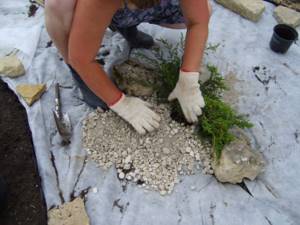
We place 2 small ones around the large stones, thus creating the effect of supporting large blocks.
Small stones can also be laid out in separate islands, 3-4 pieces each, creating the effect of zoning the composition in height.
Planting plants
. Designing a rock garden in the classic version involves the use of plants of various sizes. Tall plants should be planted near larger stones, and low-growing ones near small stones. There is no need to use too lush species; weeping plants with umbrella-shaped leaves or bonsai are perfect. Coniferous trees such as low pines, cypresses and thujas are also suitable.
It is important to maintain a balance between the number of plants and the number of stones, because after all, this is a rock garden. Therefore, it is not necessary to place plants near every stone composition.
Video review
What types of rock gardens are there?
A composition made of stones with your own hands may differ in style. Before deciding to create this or that garden decoration, think about how the decorative elements will look against the general background. Flowerpots, sculptures, fountains and other architectural forms must carry a semantic load and fit the general style of the buildings. The most popular destinations are rock gardens, Japanese gardens or Czech rolling pins.
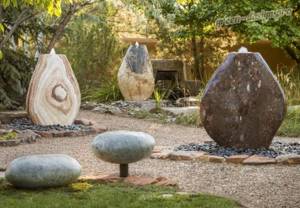
You can build many different garden decor elements from stone
For rock gardens, planting plants that are undemanding in care is suitable. The use of natural (natural) relief is allowed. The hollow can be used as a mountain gorge, the slopes turn into alpine slides, and the plains into neat (or not always) placers. Rocky rocks dominate in such designs. Smooth boulders are ideal for forming rock gardens; they are buried 2/3 into the ground.
Japanese gardens will perfectly complement the composition with a large stone. Strict and laconic forms welcome minimalist fashion. Mixes of boulders with gravel scattered on them will look great.
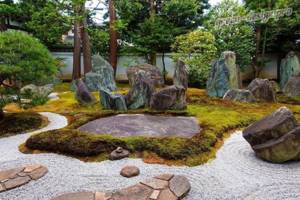
Japanese Zen Stone Garden
On top you can make incredible patterns in the form of waves. These fragments can complement many buildings made in strict geometry. But the use of such products in country style or in the “a la russe” style is not allowed.
You can also see more photos of the Japanese rock garden in our photo gallery.
The Czech rolling pin is formed by laying stones in a vertical direction. Plates of different lengths and thicknesses are placed in a specific area. Beautiful plants, coniferous compositions with stones, and bulbous flowers are planted between them. Give preference to perennial crops.
Wave-like shapes are also appropriate in such designs. In this case, it is better to use cobblestones, large blocks and a small amount of garden crops. The main point that needs to be emphasized is to repeat the wavy lines and combine them according to the color scheme. If there are wooden buildings nearby, the lawn can be mulched by applying a brown material in the same color to the logs.
Decorating a rock garden
In order for the composition to look complete, it is necessary to mask all the errors that we might have made during its construction. This may not be closed ground around the perimeter. Some stones may not be very beautiful, etc. All these imperfections can be covered with moss.
You can apply wavy lines to sand or crushed stone, creating some kind of simple ornament. But it is not at all necessary to do this, since this drawing is not a fundamentally important element.
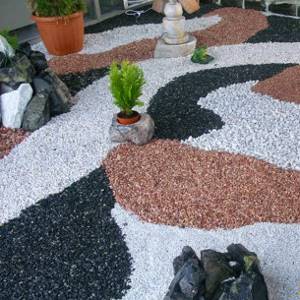
You can install lanterns and garden sculptures around the garden. Near it you can organize a recreation area, for example a pergola, or make a fountain or an artificial pond. Nothing limits you from using any landscape design elements. It is only important to maintain harmony.
Options for beautiful compositions of stones in garden design
A composition made of stone can be very diverse. It all depends on possibilities, creative thinking and imagination. Let's look at some interesting ideas.
Game of contrasts
By combining rocks and water, you can form original compositions, playing with contrasting solutions. The use of fountains, streams or ponds with exquisite granite or tuff banks is allowed. This creates the illusion of nature in its purest form.
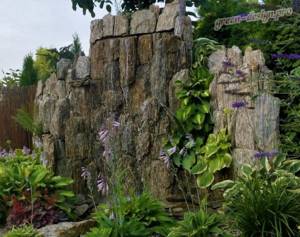
An excellent option for combining stone and water
Before decorating the banks with flagstone, seal them using film materials for the bottom. The concreting method is also suitable.
Retaining walls
Dry masonry retaining walls are popular in rocky gardens. If concrete is missing, it can be easily replaced with soil, and plants can be planted in the cracks. The growth of roots guarantees the strengthening of the structure.
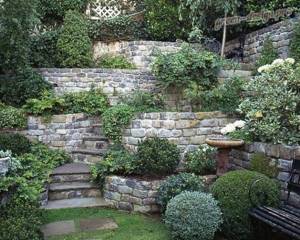
A retaining wall can also become an element of a garden landscape
If there is a natural edge on the site, stairs can be erected there. Blocks that are not processed often become a fragment of a mountain path. To add exoticism, the stone composition is complemented with moss. Moss develops quite quickly if it is pre-soaked in a special nutrient solution.
Stone benches
If there is a terrace or other recreation area or summer kitchen on the site, you can supplement them with benches made of stones.
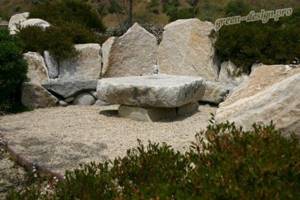
An excellent solution to build a table and benches from raw stone
Also, original tables and benches are made from local stones. When using Alpine motifs in design, the hearth and benches are created using similar rocks. The main rule is to fit harmoniously into the environment.
Composition of stones and driftwood
Decorative driftwood and stones are quite difficult to combine. But, if you balance the number of elements, you can form a rock garden-rutaria.

Stones and old stumps or driftwood look great against the backdrop of the garden
Beautiful driftwood or log elements are laid out next to the stones. The order of arrangement of such fragments can be chaotic or pre-thought out. The unifying detail of these two elements is green moss.
Care of the composition
The rock garden is easy to care for, but it still needs a little attention.
The main problem of this area is, of course, weeds.
. They need to be removed in time so that they do not develop their root system. This must be done by removing them from the soil along with the roots.
Another important task is watering the plants.
. This must be done in accordance with the recommendations for caring for exactly the plants that you used so that they do not die.
Clearing the site of debris
. From time to time, our garden needs to be cleared of fallen leaves and other debris to maintain its attractive appearance. This can be done with a wire rake, which is sold at any hardware store.
Cleansing stones
. You may have to clean the stones from excess moss that has grown once every few years. This is easy to do with some kind of scraper or spatula. But this must be done carefully so as not to scratch the stone itself, otherwise it will lose its natural appearance.
Photo gallery, 34 original photos
How to beautifully and correctly lay stones in a flowerbed
The advantage of a stone flower bed is that stones of any size and configuration can be laid on it. Any natural or artificial stone material will be appropriate here.
For roses
A stone flower bed of roses can perfectly decorate even the most inconspicuous area. The combination of the “queen of flowers” and stones gives an effect of extraordinary beauty! For such a flower garden, a small plot of land is enough - approximately 1.5 * 1.5 m.
Since roses themselves are incredibly beautiful, there is no need to invent something complicated for them: placing flower beds at different heights or combining roses with other plants. A flower bed of roses of the same variety with a border lined with rubble stones or medium-sized gravel will look great.
From thuja
A stone flowerbed of thuja can be made up of plants of the same variety or from different varieties of thuja. Such a flowerbed should be quite large in size, since thuja is a tall and spreading plant.
A flower bed made of thujas looks more attractive not when framed by stones, but when the stones are randomly arranged between the plants: this is how they decorate a rockery. The stones can be any, but preference should be given not to pebbles, but to “wild stones” with jagged edges. Rocky stones are more reminiscent of a mountain landscape where coniferous plants grow naturally.
Stones should ideally be of three types in size: large, medium and small for backfilling. In such a rock garden, stones should prevail. Thujas can form a group of three identical specimens. If the thujas are selected from different varieties and differ in size, needle color and shape, then they can be dispersed throughout the flower garden.
A simple composition of thujas and stones can be complemented by a dry stream, cascade or small pond.
From perennials
For a flower bed of perennial plants, it is better to choose a border made of stones. Because over time, the plants grow greatly and may well completely cover the stones laid between them, and even more so the stone fill. A border made of stones for such a flower bed can be made from both regular-shaped stones - bricks and blocks, and from “wild stones” with uneven edges.
If you definitely want to place stones between plants, then choose low-growing varieties and plant them at a sufficient distance from each other. Then the stones will not be hidden in the spreading foliage of perennials.
How to make a stone border for a flowerbed with your own hands
The easiest way to make a stone flowerbed is by fencing the flowerbed with stones. If the stones are not very large, then they can be laid directly on the ground. A foundation should be made from large stones under the curb.
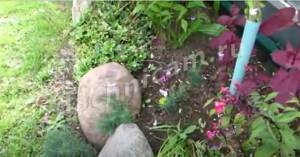
Small stones can simply be pushed slightly into the ground.
To make a border for a flower bed, you should proceed in the following sequence:
- Create a detailed plan of the future flower garden on graph paper with reference to the area.
- Level and clear the area intended for the flower bed from debris and weeds.
- Mark on the ground the contours of the future flower bed and its fencing according to a pre-drawn plan. The fence must have internal and external boundaries. Straight lines can be marked with pegs and rope, and oval contours with sand.
- Start building the foundation. Dig a shallow trench for the fence made of small stones and a deeper one (about 30 cm) for large stones. The width of the groove should correspond to the size of the stones. Fill the bottom of the groove with sand and cover it with polyethylene or roofing felt. The foundation for large stones can be a layer of crushed stone or gravel filled with cement. For low stone fences - less than 60 cm - cement for the foundation may not be used.
- Lay out the stones in one or more rows. If the stones are uneven and do not stack well on top of each other, then they need to be fastened together with cement. The top edge should have a slight slope towards the inside of the flowerbed. Make this slope using a cement joint.
Plants can be planted in such a flowerbed after a week. Beautiful flower beds lined with stone differ significantly from simple flower beds without fencing and are perceived as independent architectural structures.
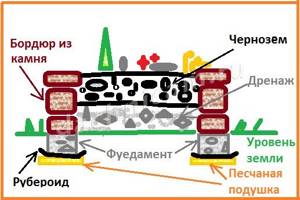
A raised flower bed with a cut-away stone border.
Photos of original do-it-yourself stone flower beds
Here are examples of stone flower beds that you can make with your own hands, depending on your level of preparation:
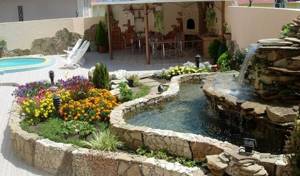
1. A stone flowerbed in an ensemble with a waterfall looks very harmonious: living water plays along with the colorful plants.
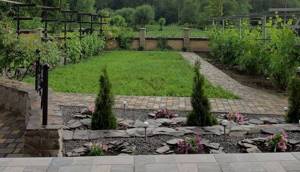
2. In this regular-style stone flowerbed, everything is organized very succinctly: vertical gardening in the form of thujas contrasts with small bouquets of petunias.

3. The monochrome pink color of the petunias stands out well against the gray background of the stones.
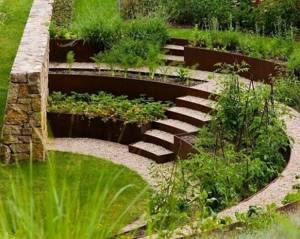
4. The multi-tiered stone flowerbed is arranged in the form of a Roman amphitheater with a cascade of steps. A straight retaining wall acts as a limiter for the entire composition.
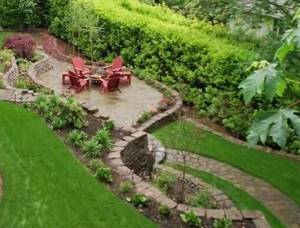
5. This stone flowerbed has several tiers of free form and perfectly frames the seating area.
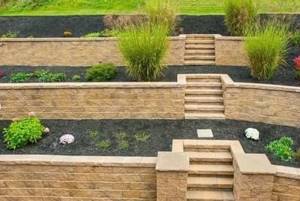
6. This multi-level stone flower bed is made in a regular style in the spirit of minimalism.
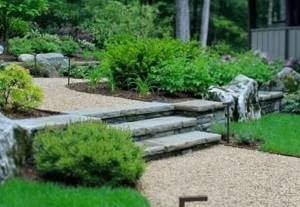
7. Monumental steps that turn into a retaining wall made of processed and unprocessed stones are the accent of this ensemble. Plants play a secondary role here.
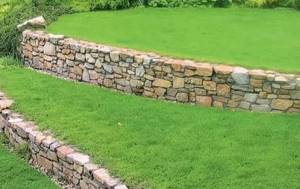
8. An interesting solution is to transform an ordinary lawn into a kind of stone multi-level flowerbed.
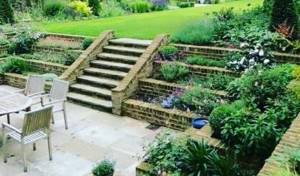
9. This composition perfectly organizes the space allocated for a relaxation corner. Such a simple flower bed looks very beautiful at the same time.
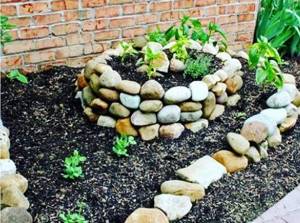
10. Using stones and cement, you can make such an original composition in the form of a vase.
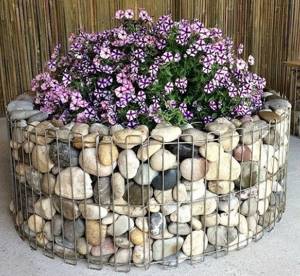
11. Any compositions made from gabions, even the simplest ones, look very impressive.
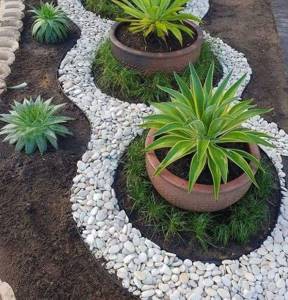
12. Adding flower pots to the composition allows you to further decorate the stone flowerbed.

13. A basket of stones and cement looks like a small architectural form.
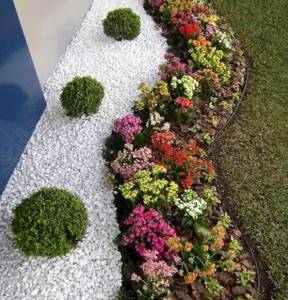
14. This stone flower bed successfully combines white stone fill with small green islands with a bright variegated ribbon of flowering plants.

15. Gabions of different heights and sizes look great installed in any order.
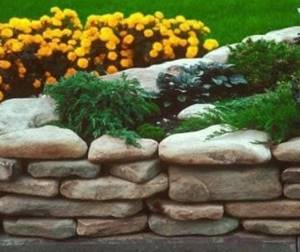
16. An interesting solution here is to move the bright spot of marigolds outside the stone flowerbed.
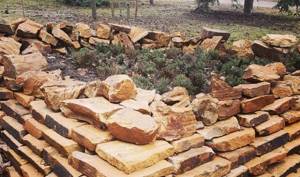
17. Stones can be laid either in a neat pyramid or absolutely chaotically. Such a corner resembles an island of wildlife.
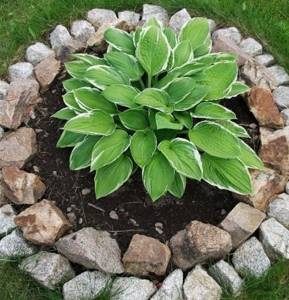
18. In this case, the hosta is the only plant in the flower garden and attracts everyone's attention.
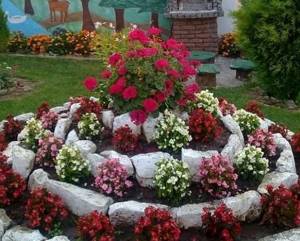
19. This stone flowerbed is decorated with bright flowers. The brightness of their colors is emphasized by the whiteness of the stones.
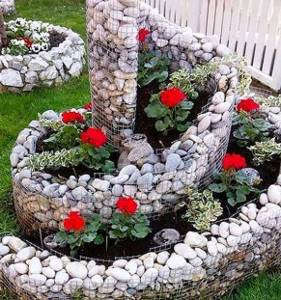
20. This composition is designed in such a way that all attention is concentrated on the intricate shape of the gabion. Bright flowers enhance the impression.
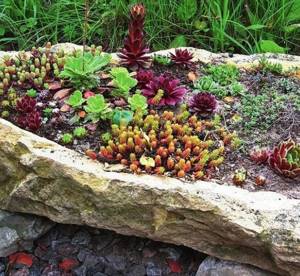
21. This stone flowerbed is rich in interesting small details. The stone acts as a frame for this charming living picture.
Fake diamond
It is obtained by mixing natural rocks with polyesters and acrylic compounds. It looks attractive, most often imitates granite and other expensive rocks, but its price is much lower.
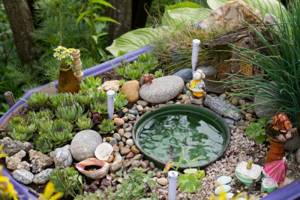
However, under the influence of the sun, temperature changes, chemicals and precipitation, it may lose its attractiveness over time.

